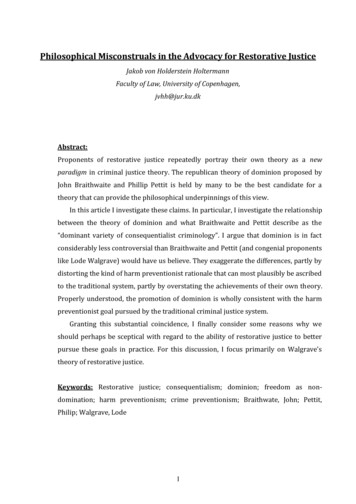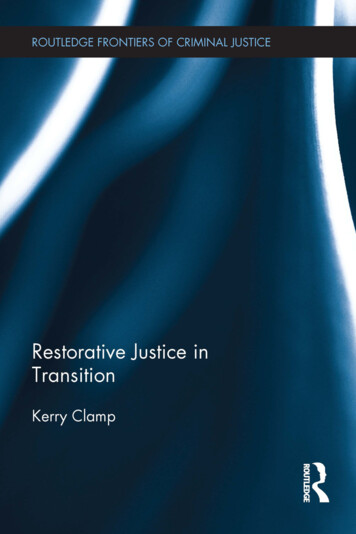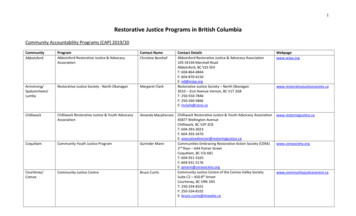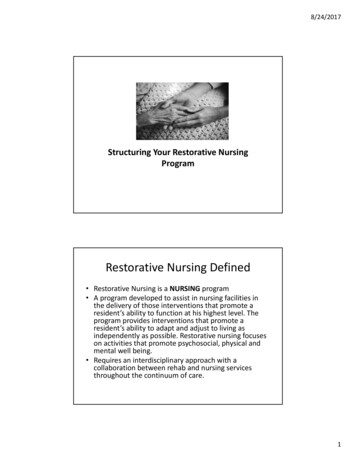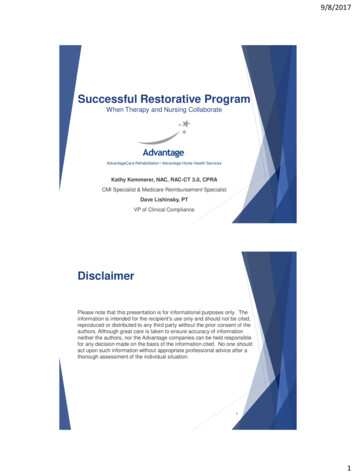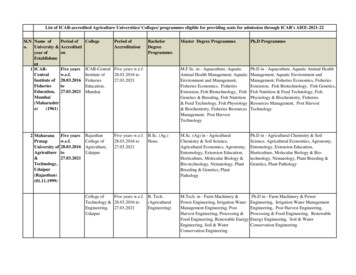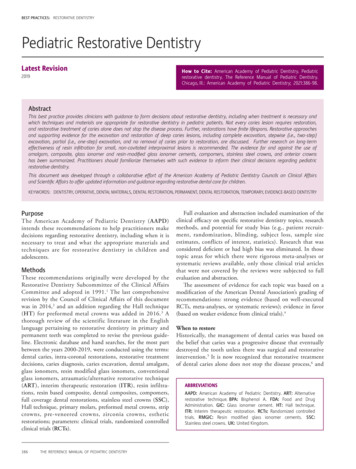
Transcription
Handbook onRESTORATIVEJUSTICEPROGRAMMESSECOND EDITIONCRIMINAL JUSTICE HANDBOOK SERIES
This publication has been prepared in collaborationwith the Thailand Institute of Justice.Cover photo: Fotofermer – stock.adobe.com
UNITED NATIONS OFFICE ON DRUGS AND CRIMEViennaHandbook on Restorative Justice ProgrammesSecond EditionCRIMINAL JUSTICE HANDBOOK SERIESUNITED NATIONSVienna, 2020
United Nations, March 2020. All rights reserved, worldwide.The designations employed and the presentation of material in this publication do not imply the expression of any opinion whatsoever on the part of the Secretariat of the United Nations concerning the legalstatus of any country, territory, city or area, or of its authorities, or concerning the delimitation of itsfrontiers or boundaries.This publication has not been formally edited.Publishing production: English, Publishing and Library Section, United Nations Office at Vienna.
AcknowledgementsThis Second Edition of the Handbook on Restorative Justice Programmes has been developed forthe United Nations Office on Drugs and Crime (UNODC) by Yvon Dandurand, Fellow andSenior Associate at the International Centre for Criminal Law Reform and Criminal JusticePolicy, and Annette Vogt, School of Criminology and Criminal Justice, University of the FraserValley, Canada, in close collaboration with Jee Aei (Jamie) Lee, Crime Prevention and CriminalJustice Officer at UNODC.In November 2017, as mandated by the Economic and Social Council resolution 2016/17,UNODC convened an expert group meeting in Ottawa, Canada, to review the use and application of the Basic Principles on the Use of Restorative Justice Programmes in Criminal Matters, as wellas new developments and innovative approaches in the area of restorative justice. In thismeeting, it was recommended by experts that “additional practical guidance” be developed onvarious issues concerning restorative justice in criminal matters. This request was made again atthe 27th session of the Commission on Crime Prevention and Criminal Justice, when MemberStates requested UNODC to update the First Edition, published in 2006, of the Handbook onRestorative Justice Programmes.Accordingly, UNODC undertook to produce a revised version of the handbook. The reviseddraft was reviewed at an expert group meeting held in Bangkok, Thailand, from 17 to 19 June2019. UNODC wishes to acknowledge the valuable suggestions and contributions of the following experts who participated in that meeting: Daniel Achutti, Vongthep Arthakaivalvatee,Daniela Bolívar Fernandez, Tim Chapman, Maia Chochua, Jon Everest, Mohammad Farajiha,Rasim Gjoka, Ali Gohar, Matti Joutsen, Kittipong Kittayarak, Marian Liebmann, Ian Marder,Anna Matczak, Don John Omale, Marilou Reeve, Fernanda Fonseca Rosenblatt, WanchaiRoujanavong, Phiset Sa-ardyen, Brian Steels, Stephan Terblanche, Ramkanta Tiwari, EditTörzs, Jutharat Ua-amnoey, Howard Varney, Sittisak Wanachagit, Hiroyuki Watanabe andAnnemieke Wolthuis.The following UNODC staff contributed to the development of this handbook: Sophie Dowsett,Anika Holterhof, Valérie Lebaux and Sonya Rahaman.UNODC also wishes to acknowledge the support provided by the Government of Thailandtowards the development and revision of the handbook.iii
ContentsPreface What the handbook covers 111. Restorative justice and the criminal justice process 1.1 What is restorative justice? 1.2 Objectives of restorative justice 1.3 Benefits of restorative justice 1.4 International standards and norms on restorative justice 1.5 Legislative framework 345810102. Overview of standards and norms, including the Basic Principles onthe Use of Restorative Justice Programmes 152.1 Use of terms 152.2 Rights of parties 162.3 Legal and policy safeguards 162.4 Other relevant international standards and norms 172.5 National guidelines and standards 203. Types of restorative justice processes and programmes 3.1 Different applications of a restorative justice approach in criminal matters 3.2 Main types of processes 3.3 Quasi-restorative justice processes 3.4 Other applications of restorative justice approaches in the criminaljustice system 23232437384. Restorative justice programmes at various stages of the criminaljustice process 4.1 Pre-charge diversion 4.2 Trial and sentencing stage 4.3 Post-sentencing 4.4 Role of criminal justice practitioners in restorative justice 41424242445. Requirements for successful operation of restorative justice programmes 5.1 Promoting appropriate referrals to a programme 5.2 Self-referrals by victims and offenders 5.3 Adequate and appropriate preparation of participants 5.4 Facilitation of a restorative justice process 5.5 Agreement reached as a result of a restorative process 5.6 Available and effective programme support services 5.7 Community engagement and relations with the media 4949555657626464v
6. Restorative justice responses to serious crimes 6.1 Common concerns in cases involving serious crime 6.2 Restorative justice for specific types of serious crimes 6769737. Establishing and implementing restorative justice programmes 7.1 National guidelines 7.2 Strategic approaches 7.3 Programme design and implementation 7.4 Addressing the need for a legal framework 7.5 Leadership, organization and programme structure 7.6 Securing support from criminal justice organizations 7.7 Mobilizing the community 7.8 Improving the participation of victims in restorative justice process 81818285929495971008. Programme oversight, monitoring and evaluation 8.1. Programme oversight 8.2 The need for programme monitoring and evaluation 8.3 Considerations in evaluating restorative justice programmes 8.4 Measuring programme impact on reoffending 103103104105107Conclusion 111ANNEX. United Nations Basic Principles on the Use of Restorative JusticeProgrammes in Criminal Matters 113vi
PrefaceRestorative justice is a flexible, participatory and problem-solving response to criminal behaviour, which can provide a complementary or an alternative path to justice. It can improve accessto justice, particularly for victims of crime and vulnerable and marginalized populations, including in transitional justice contexts. Restorative justice has a great potential to contribute to theachievement of Sustainable Development Goal (SDG) 16 on providing access to justice for alland building effective, accountable and inclusive institutions at all levels.As part of the Criminal Justice Handbook Series, a series of practical tools developed by theUnited Nations Office on Drugs and Crime (UNODC) to support countries in the implementation of the rule of law and criminal justice reform, this handbook aims to provide an overviewof the concept, values and principles of restorative justice as well as practical guidance onrestorative justice programmes and processes.The handbook is designed to be used by all actors in the criminal justice system – includingpolicymakers, legislators, criminal justice professionals, community groups, restorative justicepractitioners, members of civil society and other individuals, and entities active in the field ofcriminal justice reform – in a variety of contexts, both as a reference document and a trainingtool. It has also been designed to be used in conjunction with the Training Curriculum onRestorative Justice, a tool developed by UNODC to provide guidance on strengthening thecapacity to deliver restorative justice services.What the handbook coversThe main objective of this handbook is to provide, in a clear and concise fashion, an overviewof the merits of restorative justice programmes and of good practices in their design andimplementation. The handbook covers a wide range of issues concerning restorative justiceprogrammes: applicable standards; various types of programmes; programme design andimplementation issues; the dynamics of restorative justice interventions; programme development and operation and the mobilization of community assets; as well as programmemonitoring and evaluation. The emphasis is on presenting information and examples thatwill be useful in the development of new programmes in a variety of social, cultural andlegal contexts.1
2HANDBOOK ON RESTORATIVE JUSTICE PROGRAMMESThe handbook contains eight chapters:Chapter 1 offers a simple introduction to restorative justice, its underlying principles, objectivesand benefits. Acknowledging that there are many different definitions of restorative justice, itclarifies how it is defined for the purpose of this handbook.Chapter 2 introduces the United Nations Basic Principles on the Use of Restorative JusticeProgrammes in Criminal Matters (hereinafter, the Basic Principles) as well as other relevant international standards relating to the use of restorative justice in specific contexts. It also offersexamples of guidelines that have been established to steer the development and operation ofrestorative justice programmes.Chapter 3 provides an overview of the most common types of restorative justice programmes,including victim offender mediation programmes, group conferencing, circle processes andcommunity panels or boards. It covers the relationship between restorative justice and indigenous and customary justice forums and refers to the application of restorative justice in thetransitional justice context.Chapter 4 explains how restorative justice interventions can be practiced not only as an alternative, but also as a complement to the criminal justice process at every stage of the process,including: the pre-trial stage as diversion from prosecution; the trial and sentencing stages; andat the post-sentencing stage as an alternative to imprisonment, as part of or in addition toa non-custodial sentence, during imprisonment, or upon release from prison as part of anoffender’s reintegration process.Chapter 5 relates some of the lessons learned about the main factors responsible for thesuccessful operation of restorative justice programmes. Key among them are the safe and meaningful engagement of victims and other participants, the promotion of appropriate referrals tothe programmes and awareness raising about restorative options, adequate preparation of participants, competent facilitation of the process, effective programme support and positive community engagement.Chapter 6 introduces the question of applying restorative justice responses to serious crime.It discusses how to address common concerns about the application of restorative justice incases involving serious crimes, including concerns for the safety and welfare of victims. Thechapter also reviews the question of the application of restorative justice approaches to specificcrimes, such as domestic violence, intimate partner violence, violence against children, sexualviolence and hate crimes.Chapter 7 proposes a strategic approach to establishing restorative justice programmes.It reviews key aspects of the effective implementation of sustainable restorative justice programmes, including addressing the need for legislation or regulations as well as the need forleadership, defining the programme’s organization and structure, securing support from criminal justice organizations, identifying and mobilizing community assets and building on theexisting strengths of the community and the justice system, and careful planning and monitoring of the implementation process.Chapter 8 emphasizes the need for programme oversight, monitoring and evaluation and discusses the importance of evaluating restorative justice programmes, measuring their impact anddisseminating information about good practices.
1.Restorative justice and thecriminal justice processRestorative justice programmes are based on the belief that the parties involved in or affected bycrime ought to participate actively in repairing the harm, alleviating the suffering that it causedand, whenever possible, taking steps to prevent the reoccurrence of the harm. This approach isalso seen as a means to promote tolerance and inclusiveness, uncover truth, encourage thepeaceful expression and resolution of conflict, build respect for diversity and promote responsible community practices.This is not a new approach. Restorative justice has historic roots that can be traced in mostsocieties prior to the development of modern criminal justice systems. It continues to bepractised through indigenous and customary approaches to justice and conflict resolution.Restorative justice processes can be adapted to various cultural contexts and the varying needsof different communities.There is growing support for the management and resolution of social conflict through dialogueand community participation mechanisms, including by promoting restorative justice.1New and established forms of restorative justice offer communities some welcome means ofresolving conflicts and reducing the harm caused by criminal behaviour. They involve individuals who are directly involved in or affected by crime, including, in some instances, members ofthe community. These processes are particularly adapted to situations where the parties participate voluntarily and each one has an opportunity to engage safely in a facilitated dialogue toarrive at a common understanding and agreement.This handbook focuses on restorative justice programmes in criminal matters, but one shouldremember that restorative processes are also successfully being used to address and resolveconflict and harm in a variety of other contexts and settings, including families, schools,neighbourhoods, sports, the workplace, prisons and even in dealing with complaints againstthe police.1Thirteenth United Nations Congress on Crime Prevention and Criminal Justice, Doha Declaration on integrating crime prevention and criminal justice into the wider United Nations agenda to address social and economicchallenges and to promote the rule of law at the national and international levels, and public participation, Doha,Qatar, 12–19 April 2015 (see A/CONF.222/L.6), para. 10.3
4HANDBOOK ON RESTORATIVE JUSTICE PROGRAMMES1.1What is restorative justice?Restorative justice is an approach that offers offenders, victims and the community an alternativepathway to justice. It promotes the safe participation of victims in resolving the situation andoffers people who accept responsibility for the harm caused by their actions an opportunity tomake themselves accountable to those they have harmed. It is based on the recognition that criminal behaviour not only violates the law, but also harms victims and the community.The literature offers many different definitions of restorative justice. This is due to the diverseand evolving nature of restorative justice approaches around the world. Some definitions placethe emphasis on the participatory aspect of the process and on encounters and active participation through dialogue. Others stress restorative outcomes such as reparation, victim recoveryand offender reintegration. However, most definitions agree on the following elements: A focus on the harm caused by criminal behaviour Voluntary participation by those most affected by the harm, including the victim, theperpetrator and, in some processes and practices, their supporters or family members,members of a community of interest and appropriate professionals Preparation of the parties and facilitation of the process by trained restorativepractitioners Dialogue between the parties to arrive at a mutual understanding of what happenedand its consequences and an agreement on what should be done Outcomes of the restorative process vary and may include an expression of remorseand acknowledgement of responsibility by the perpetrator and a commitment to dosome reparative action for the victim or for the community An offer of support to the victim to aid recovery and to the perpetrator to aid reintegration and desistance from further acts of harmVICTIMS OF CRIMERestorative justice programmes purport to involve victims. However, the concept of “victim” is alsoone that requires operationalization for the purposes of defining a restorative justice process.According to the 1985 Declaration of Basic Principles of Justice for Victims of Crime and Abuse ofPower, victims are “persons who, individually or collectively, have suffered harm, includingphysical or mental injury, emotional suffering, economic loss or substantial impairment of theirfundamental rights, through acts or omissions that are in violation of criminal laws operativewithin Member States, including those laws proscribing criminal abuse of power”. a The Declarationalso includes in the definition of “victim”, where appropriate, the immediate family or dependantsof the direct victim and persons who have suffered harm in intervening to assist victims in distressor to prevent victimization.aUnited Nations Declaration of Basic Principles of Justice for Victims of Crime and Abuse of Power, GeneralAssembly resolution 40/34 of 29 November 1985, art. 1.For the purposes of this handbook, the term “restorative justice programmes” is given the samebroad definition as that found in the Basic Principles, that is: “any programme that uses restorative processes and seeks to achieve restorative outcomes”.22Economic and Social Council resolution 2002/12 of 24 July 2002, annex, para. 1.
1. Restorative justice and the criminal justice processThe emphasis in this definition is clearly on a participatory process defined as “any process inwhich the victim and the offender, and, where appropriate, any other individuals or communitymembers affected by a crime, participate together actively in the resolution of matters arisingfrom the crime, generally with the help of a facilitator”.3 The individuals involved in that processare referred to as the “parties”. That process takes many forms, based on different techniquesand types of dialogue. In Europe, for example, the process is more commonly known as“mediation”,4 as distinct from legal adjudication. In other parts of the world it may be referredto as “conferencing”, “dialogue”, “circle sentencing” or “peacemaking”.According to the Basic Principles, a restorative outcome is an “agreement reached as a result of arestorative process aimed at meeting the individual and collective needs and responsibilities ofthe parties and achieving the reintegration of the victim and the offender”.5 It is commonlyassumed that a restorative outcome ought to include a form of redress, compensation or reparation, but that is not necessarily always the case.A distinction is also frequently made, in relation to restorative justice outcomes, between material (e.g., monetary compensation) and symbolic forms of reparation.6 A symbolic form of reparation may include verification of facts, apologies and official apologies, public acknowledgementof the harm done, satisfaction with preventive measures taken, commemoration, guarantees ofnon-repetition and voluntary service to a community or charitable organization. The outcomeof a restorative justice process often includes both forms of reparation. Offenders, particularlyyoung offenders, do not always have the means to make financial reparation, but gestures suchas an apology, an acceptance of responsibility, community service or an undertaking not torepeat the offence, may carry a beneficial role for the victims or the community by producing asense of justice being done, healing and closure.7 In some instances the process may lead toreconciliation between the parties.1.2Objectives of restorative justiceRestorative justice practitioners tend to agree that what truly makes a particular response tocrime a “restorative” one is not only a specific practice or process, but more importantly itsadherence to a broad set of values that provide a common basis for the participation of partiesin responding to a criminal incident and its consequences.8 These values include truth, fairness,physical and emotional safety of participants, inclusion, empowerment of participants, safeguarding of victims’ and offenders’ rights, reparation, solidarity, respect and dignity for allinvolved, voluntariness and transparency of process and outcomes.Economic and Social Council resolution 2002/12 of 24 July 2002, annex, para. 2.See Council of Europe (2018), Recommendation CM/Rec(2018)8 concerning restorative justice in criminalmatters.5Economic and Social Council resolution 2002/12, annex, para 3.6See, for example, the 2005 United Nations Basic Principles and Guidelines on the Right to a Remedyand Reparation for Victims of Gross Violations of International Human Rights Law and Serious Violations ofInternational Humanitarian Law (General Assembly resolution 60/147 of 16 December 2005), which characterizesreparations according to whether they are symbolic or material in nature.7Doak, J., “Honing the Stone: Refining restorative justice as a vehicle for emotional redress”, ContemporaryJustice Review, 14(4), pp. 439–456.8See, for example, Chapman, T. and Törzs, E. (eds.) (2018), Connecting People to Restore Just Relations: Practiceguide on values and standards for restorative justice practices, Leuven: European Forum for Restorative .pdf.345
6HANDBOOK ON RESTORATIVE JUSTICE PROGRAMMESVALUES GUIDING RESTORATIVE JUSTICE PRACTICEReparation: Focus on acknowledging and repairing the physical, emotional and financial harmcaused by crime and meeting the needs of those affected.Respect: Treat all participants with dignity, compassion and equal consideration.Voluntariness: Ensure the participation of victims, offenders and community members is voluntary,and based on free, informed and ongoing consent.Inclusion: Foster and support the meaningful participation of those affected, including victims,offenders, their friends, their families and their communities.Empowerment: Enable participants to communicate openly and honestly and to have an active rolein determining how to address their needs, as they see them.Safety: Attend to the physical, emotional, cultural and spiritual safety and well-being of allparticipants. Participation in restorative justice should not result in further harm to any participant.Accountability: Assist those who have caused harm to acknowledge and take responsibility forharm and reparation.Transformation: Provide opportunities for understanding, healing and change, and contribute tothe restoration and reintegration of victims and offenders.Source: Department of Justice Canada (2018), Principles and Guidelines for Restorative Justice Practice in CriminalMatters, Ottawa: Justice Canada.The objectives of restorative justice programmes have been stated in a number of ways, butessentially refer to the following key elements:(a) Supporting victims, giving them a voice, listening to their story, encouraging them to express theirneeds and wishes, providing them with answers, enabling them to participate in the resolutionprocess and offering them assistanceFor the last two decades or so, criminal justice systems have been called upon to focusmore directly on the needs and interests of victims (e.g., the need for information, empowerment through participation, expression, empathy, redress, restoration of a sense of control and security). The Declaration of Basic Principles on Justice for Victims of Crime andAbuse of Power states that “informal mechanisms for the resolution of disputes, includingmediation, arbitration and customary justice or indigenous practices, should be utilizedwhere appropriate to facilitate conciliation and redress for victims”.9 A restorative justiceprocess is uniquely suited to address many of the victims’ most important needs. Therestorative justice approach can support a process where the victims’ views and interestscount, where they can participate and be treated fairly and respectfully and seek redressand reparation. By participating in the process, victims have a say in determining whatwould be an acceptable outcome for the process and take steps toward closure.10General Assembly resolution 40/34 of 29 November 1985, para. 7.Bolitho, J. (2015), “Putting justice needs first: A case study of best practice in restorative justice”, RestorativeJustice: An International Journal, 3(2), pp. 256–281; Bolívar, D. (2019), Restoring Harm: a psychosocial approach tovictims and restorative justice, Abingdon Oxon: Routledge; Hallam, M. (2014), Restoring the Balance: An Evaluationof the Project conducted through interviews with victims, offenders and those making referrals to the service, London: VictimSupport (Thames Valley Area).910
1. Restorative justice and the criminal justice process(b) Repairing the relationships damaged by the crime, in part, by arriving at a consensus on how bestto respond to itA key feature of restorative justice is its response to criminal behaviour that focuses onmore than just the offender and the offence. Peacemaking, dispute resolution, rebuildingrelationships and even reconciliation are viewed as the primary methods for achievingjustice and supporting the victim and the offender while serving the broader public safetyinterests of the community. The participatory process can also help identify underlyingcauses of crime and formulate crime prevention strategies.(c) Reaffirming community values and denouncing criminal behaviourDenouncing certain behaviours is an objective of the restorative justice process just asit has been a fundamental objective of criminal law for centuries. However, the way inwhich the behaviour is denounced is different. Social values are reaffirmed in a moreflexible manner, considering not only the rules, but the individual circumstances of theoffence, the victim and the offender. Denunciation is achieved through a positive processrather than being the sole focus of the intervention. What the denunciation looks like andhow it takes place during the restorative process varies widely, but it remains an essentialpart of it.(d) Encouraging responsibility taking by all concerned parties, particularly by offendersThe restorative process is meant to make it easier for offenders to assume responsibilityfor their behaviour and its consequences. Unlike criminal proceedings focused on determining and assessing legal guilt, a restorative justice process moves from acknowledgingresponsibility for the harm done to focusing on how the harm can be repaired and further harm avoided in the future. All parties who had a role to play in the offence or thecircumstances that led to it are encouraged to assume responsibility for the part theyplayed. How this acknowledgment of responsibility leads to action is left to be determined through the restorative process itself and not through the automatic application ofsome general legal rules. At its best, the process may lead offenders not only to assumeresponsibility for the harm done, but also to experience a cognitive and emotional transformation and improvement in their relationship with the community.(e) Identifying restorative, forward-looking outcomesRather than emphasizing the rules that have been broken and the punishment that shouldbe imposed, restorative approaches tend to focus primarily on the impact of the harmfulactions on the victim and the community. While it can help address the problem of overreliance on incarceration, a restorative justice process does not necessarily rule out allforms of punishment (e.g., fine, probation or even incarceration), but remains firmlyaimed at producing restorative, forward-looking outcomes that reduce further harm.It provides offenders with an opportunity to make meaningful reparation and to repairthe relationships damaged by their action. The restorative justice process can take placein parallel to other forms of intervention (e.g., drug treatment, mental health treatmentand supervision).7
8HANDBOOK ON RESTORATIVE JUSTICE PROGRAMMES(f)Preventing recidivism by encouraging change in individual offenders and facilitating their reintegration into the communityThe harm caused by offenders is a central preoccupation of the restorative justiceprocess, but so are offenders’ future behaviours. Victims and the community expectremorse to lead to a commitment, not only to repair the harm, but also to avoid acting ina harmful way in the future. An offender’s undertaking, as it relates to his or her futurebehaviour, is usually an essential component of agreements arrived at through mediationor other restorative processes. Transforming or “reforming” the offender through therestorative process is a legitimate and important objective of the process and so is theprevention of recidivism. The insistence that offenders understand and accept responsibility for the consequences of their actions is clearly meant to affect offenders’ futurebehaviour. The offender’s family and supportive others, the community and statutoryagencies have a role to play in this process.1.3Benefits of restorative justiceAlthough relatively few rigorous evaluations of restorative justice programmes have been conducted to date, their findings generally indicate that a restorative process, at any stage of thecriminal justice system, has greater potential than the standard justice process alone in effectively resolving conflict, securing offender accountability and meeting the needs of victims.11The following are some general findings that have emerged from programme implementationto date: Restorative justice has a positive effect in reducing the frequency and the severity ofreoffending.12 A restorative justice approach is particularly apt to promote desistance from crimeand reduce reoffending when it is part of a broader rehabilitation framework. Restorative justice programmes can be particularly effective when they target higherrisk and more serious offenders. Successful resolutions and restorative outcomes in victim-offender mediation and conferencing are possible for both property-re
3.4 Other applications of restorative justice approaches in the criminal justice system 38 4. Restorative justice programmes at various stages of the criminal justice process 41 4.1 Pre-charge diversion 42 4.2 Trial and sentencing stage 42 4.3 Post-sentencing 42 4.4 Role of criminal justice practitioners in restorative justice 44 5 .

